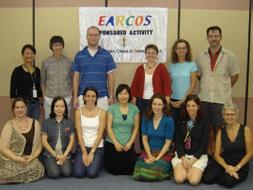
3 minute read
Weekend Workshop with Gloria Linder – Scientific Inquiry: Building Deep
These activities were coupled with opportunities to evaluate mathematical tasks as one of four categories; memorization and procedures without connections, on the lower end of cognitive demand, and procedures with connections and ‘doing math’ tasks, on the higher end of cognitive demand. So where does the 15% problem lie on this spectrum? Depending on how it was presented and facilitated by the teacher, it could have been a lower or higher end cognitive task. This led us to a case analysis by a teacher who had presented and facilitated this task in two different ways. We identified the changes in student engagement and thinking when the teacher employed the following:
* Redirected student questions by encouraging them to look more specifically at the information (in this case a diagram) that they were given. * Gave students time to struggle without intervening. * Asking more questions such as, “How can that information help you find the answer?” * Students shared work and justifications, taking time to analyze all strategies
These techniques led the students to a deeper understand ing of percents and opened the door for further connections to fractions and decimals.
The final key component for the weekend was looking at student self assessment tools which prompt deeper thinking and greater understanding of mathematical tasks. Some sample measures:
* “I justify why ideas and answers do or don’t work.” * “I use multiple representations–models, diagrams, graphs, numbers, words, math symbols, and situations from every day life to make sense of math ideas and problems.” * “I use more than one method to solve problems.” * “I use mistakes to start new learning.”
Our goals this weekend were to learn the characteristics of high cognitive demand tasks and how the cognitive demand can change through teaching techniques. Both were well modeled and practiced. We were given a few more tools and a few more nudges toward that paradigm shift which will allow us to bring out the in ner mathematicians in our students. It made for a good weekend in Bangkok.
By Nancy Harris, grade 7 math/science teacher
Weekend Workshop with Gloria Linder Scientific Inquiry: Building Deep Understanding of Science Concepts and Processes, September 27-28, 2008
It is not easy to detect the seasons here in Bangkok. Young students listen curiously as you read about cold, snowy days, and can’t imagine days or nights that never end in some parts of the world. Every day is summer to them. How can we meaningfully guide our students to build understanding of complex scientific concepts within the classroom, where actual experience is impos sible? other groups. This process allowed us to extend our understanding and walk away with a solid conceptual base on which we could attach deeper thinking in the future.
Through active engagement, Brownie also gave us a weekend of fun, challenge, and collegiality as we contemplated science and teaching.
An EARCOS weekend workshop with Gloria (Brownie) Linder provided a group of K-12 educators with a series of ac tivities modeling proven strategies that promote scientific inquiry. Brownie has been involved with professional development for teachers and administrators in science education for over 20 years. A consultant in the development of FOSS, SEPUP, GEMS, and CHEMS science kits, she has received numerous awards for her cutting edge contributions to the field of science education.
Research shows that understanding and explaining the causes of the seasons can be challenging for people of all ages. Intuition and misconception leads us to think about the distance from the sun as being the sole factor, when in fact it is more complex than that. Using an inquiry approach, Brownie led us through deep thinking to construct our own reasons for the seasons. Building models, graphing temperatures and hours of daylight, constructing and tracing shadows, and numerous other activities led us to con struct scientific explanations using evidence and reasoning. Working in collaborative groups, we could communicate our findings to










